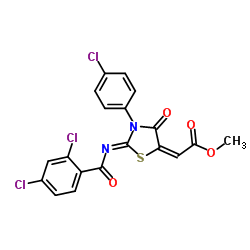| Description |
FR171113 is a specific and non-peptide thrombin receptor antagonist. FR171113 exhibits the antithrombotic effects of a PAR1 antagonist. FR171113 inhibits thrombin-induced platelet aggregation with an IC50 of 0.29 μM.[1][2][3][4].
|
| Related Catalog |
|
| In Vitro |
FR171113 shows antiplatelet effect on the aggregation of guinea pig platelets induced by PAR1 agonist peptide and thrombin in vitro with IC50s of 1.5 and 0.35 μM, respectively[2]. FR171113 (0.032-1 μM) dose-dependently inhibits platelet aggregation induced by both thrombin and TRAP-6[1]. FR171113 significantly prevents the plasma-elicited up-regulation of RAGE, MCP-1 and ICAM-1 mRNA levels in HUVECs[2]. FR171113 (1 μM; pretreatment for 30 minutes) inhibits thrombin- and SFLLRN (human PAR1 agonist peptide)-induced ERK activation, but not factor Xa- or SLIGKV (PAR2 agonist peptide)-induced ERK activation, indicating that activation of ERK by factor Xa is specifically mediated by PAR2 in mesangial cells[3]. Cell Viability Assay[1] Cell Line: Human washed platelets Concentration: 0.001, 0.01, 0.1, 1, 10, 100 μM Incubation Time: Result: The IC50 value for thrombin-induced platelet aggregation was 0.29 μM. The IC50 value for TRAP-6-induced platelet aggregation was 0.15 μM. RT-PCR[2] Cell Line: human umbilical vein endothelial cells (HUVECs) Concentration: 1 μM Incubation Time: 4 hours Result: 3% citrated human plasma-evoked ROS generation, RAGE, MCP-1 and ICAM-1 gene induction was significantly blocked. Western Blot Analysis[3] Cell Line: Mesangial cells Concentration: 1 μM Incubation Time: Pretreatment for 30 minutes Result: Pretreatment inhibited thrombin (10 nM; for 5 minutes)- and SFLLRN(100 μM for 5 minutes)-induced ERK activation.
|
| In Vivo |
FR171113 suppresses occlusive thrombosis dose dependently and causes significant prolongation at 1 mg/kg s.c. in the carotid artery thrombosis model.FR171113 shows antiplatelet and antithrombotic effects in vivo. FR171113 is a useful agent for investigating antithrombotic actions via PAR1 in vivo[4]. Animal Model: Male Hartley guinea pigs (650–950 g) were anesthetized with urethane (1.25 g/kg, i.p.)[4] Dosage: 0.32, 1.0, and 3.2 mg/kg Administration: Administered subcutaneously (s.c.) Result: Pretreatment with FR171113 prolonged this parameter in a dose-dependent manner. The time to thrombotic occlusion for 0.32, 1.0 and 3.2 mg/kg of FR171113 was 30.7±5.36, 44.7±8.41 and 92.6±9.79, respectively.
|
| References |
[1]. Y Kato, et al. In vitro antiplatelet profile of FR171113, a novel non-peptide thrombin receptor antagonist. Eur J Pharmacol. 1999 Nov 19;384(2-3):197-202. [2]. Yuji Ishibashi, et al. Advanced glycation end products potentiate citrated plasma-evoked oxidative and inflammatory reactions in endothelial cells by up-regulating protease-activated receptor-1 expression. Cardiovasc Diabetol. 2014 Mar 13;13:60. [3]. Misa Tanaka, et al. Role of coagulation factor Xa and protease-activated receptor 2 in human mesangial cell proliferation. Kidney Int. 2005 Jun;67(6):2123-33. [4]. Yasuko Kato, et al. Inhibition of arterial thrombosis by a protease-activated receptor 1 antagonist, FR171113, in the guinea pig. Eur J Pharmacol. 2003 Jul 25;473(2-3):163-9.
|

